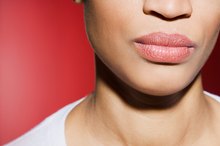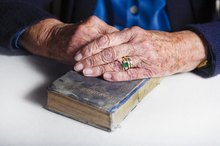What does fact checked mean?
At Healthfully, we strive to deliver objective content that is accurate and up-to-date. Our team periodically reviews articles in order to ensure content quality. The sources cited below consist of evidence from peer-reviewed journals, prominent medical organizations, academic associations, and government data.
The information contained on this site is for informational purposes only, and should not be used as a substitute for the advice of a professional health care provider. Please check with the appropriate physician regarding health questions and concerns. Although we strive to deliver accurate and up-to-date information, no guarantee to that effect is made.
How to Reduce Black Spots on the Face
Day after day, your face gets exposed to sunlight and a slew of skin-damaging pollutants. It's no surprise that your facial skin often shows the first signs of skin problems. Dark spots, usually black or brown in color, can pop up on people of any skin type or complexion. Several things can trigger these spots -- hormonal changes, excessive sun exposure and genetics, to name a few. Dark spots sometimes fade on their own, but others need a bit of prodding to disappear. Over-the-counter solutions may help, but if they aren't effective, you might benefit from a prescription-strength treatment.
Wash your face in the morning and before bed to clear your skin of makeup, dirt and oil. These elements can clog pores, making dark patches look worse. For dry skin, use a cream-based cleanser. If you have oily or combination skin, opt for foam- or gel-based cleanser. Use a cleanser that contains salicylic, lactic or glycolic acid if you have oily skin. If your skin is normal, choose a cleanser designed for that skin type. To wash, wet your face with lukewarm water, then gently massage the cleanser into skin using small, circular motions. Rinse well and pat dry with a soft, clean towel.
How to Get Rid of Freckles With Vitamin C
Learn More
Treat skin once daily with an over-the-counter skin-lightening serum that contains retinol, glycolic acid, vitamin C or kojic acid. Vitamin C, kojic acid and retinol work by inhibiting the melanin-creating enzyme named tyrosinase. Glycolic acid and similar ingredients fade dark spots by chemically exfoliating off excess melanin on the top layer of skin cells.
Other ingredients to look for are niacinamide, licorice extract, azelaic acid and arbutus, which also inhibit the enzyme tyrosinase. Follow the application directions on a serum's packaging for best results. Purchase a serum at a drugstore or the beauty department of a grocery or department store.
Apply a prescription-strength hydroquinone cream if over-the-counter treatments do not work 4. Hydroquinone bleaches dark spots by breaking down melanin pigment granules and inhibiting tyrosinase 4. Twice daily, smooth a thin layer of hydroquinone cream over clean skin 4. Only apply the cream to dark spots; it will lighten any skin it touches. For very small spots, apply cream with a cotton swab or clean, thin makeup brush. Rinse well with lukewarm water. You should see a lightening effect in a few days, but it can take about four weeks for real change. If you don't see an effect within three months, stop using the product.
How to Get Rid of Dark Circles Around the Mouth
Learn More
Ask a doctor or dermatologist about a peel or laser treatment if hydroquinone doesn't work 4. These treatments work best if discoloration is close to the skin's surface. The treatments aren't permanent, however. Results may last for several weeks or a few years.
Tips
After an abrasion, burn or pimple heals, it can leave behind a dark spot. This is called post-inflammatory hyperpigmentation, and the spots usually fade on their own in three to six months.
To protect skin from UV damage, wear a sunscreen that contains an SPF of 15 to 30 when you go outdoors. The sun's rays can cause skin discoloration or make dark spots worse.
Citrus, tomato and pineapple juice may lighten dark spots when applied to the skin over time. This remedy may not be very effective, though, and it can take a long time to see results.
Warnings
Hydroquinone may irritate skin. It can cause mild stinging, itching or reddening. If you notice severe itching, swelling, burning or crusting, stop using the treatment immediately and seek medical help.
When spots start showing up, don't wait -- get a skin exam as soon as possible. Some spots can be early indicators of cancer.
Related Articles
References
- Essence: Ask the Experts: How To Get Rid of Dark Spots
- Jeffrey Spiegel MD: How to Get Rid of Those Brown Spots on Your Face
- NCBI: Postinflammatory Hyperpigmentation
- DermNet NZ: Hydroquinone
- Decker A, Graber EM. Over-the-counter Acne Treatments: A Review. J Clin Aesthet Dermatol. 2012;5(5):32-40.
- Davis EC, Callender VD. Postinflammatory hyperpigmentation: a review of the epidemiology, clinical features, and treatment options in skin of color. J Clin Aesthet Dermatol. 2010;3(7):20-31.
- Fabbrocini G, Annunziata MC, D'arco V, et al. Acne scars: pathogenesis, classification and treatment. Dermatol Res Pract. 2010;2010:893080. doi:10.1155/2010/893080
- Kubba R, Bajaj AK et al. Postinflammatory Hyperpigmentation in Acne. India Journal of Dermatology, Venereology and Leprology. 2009;75(7):54.
- Sharad J. Glycolic acid peel therapy - a current review. Clin Cosmet Investig Dermatol. 2013;6:281-8. doi:10.2147/CCID.S34029
- Sarkar R, Arora P, Garg KV. Cosmeceuticals for Hyperpigmentation: What is Available? J Cutan Aesthet Surg. 2013;6(1):4-11. doi:10.4103/0974-2077.110089
- Sofen B, Prado G, Emer J. Melasma and Post Inflammatory Hyperpigmentation: Management Update and Expert Opinion. Skin Therapy Lett. 2016;21(1):1-7.
- Leyden J, Stein-gold L, Weiss J. Why Topical Retinoids Are Mainstay of Therapy for Acne. Dermatol Ther (Heidelb). 2017;7(3):293-304. doi:10.1007/s13555-017-0185-2
- Bandyopadhyay D. Topical treatment of melasma. Indian J Dermatol. 2009;54(4):303-9. doi:10.4103/0019-5154.57602
- Decker A, Graber EM. Over-the-counter Acne Treatments: A Review. J Clin Aesthet Dermatol. 2012;5(5):32-40.
- Mohamed Ali BM, Gheida SF, El Mahdy NA, Sadek SN. "Evaluation of Salicylic Acid Peeling in Comparison with Topical Tretinoin in the Treatment of Postinflammatory Hyperpigmentation." Journal of Cosmetic Dermatology. 2017 Mar;16(1):52-60.
- Sarkar R, Parmar NV, Kapoor S. "Treatment of Postinflammatory Hyperpigmentation With a Combination of Glycolic Acid Peels and a Topical Regimen in Dark-Skinned Patients: A Comparative Study." Dermatologic Surgery. 2017 Apr; 43(4):566-573.
- Shokeen D. "Postinflammatory Hyperpigmentation in Patients with Skin of Color." Cutis. 2016 Jan;97(1):E9-E11.
Writer Bio
Melissa King began writing in 2001. She spent three years writing for her local newspaper, "The Colt," writing editorials, news stories, product reviews and entertainment pieces. She is also the owner and operator of Howbert Freelance Writing. King holds an Associate of Arts in communications from Tarrant County College.









